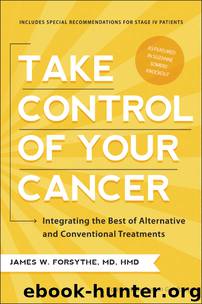Take Control of Your Cancer by James Forsythe

Author:James Forsythe [Forsythe, James W.]
Language: eng
Format: epub
ISBN: 9781936661800
Publisher: BenBella Books, Inc.
OTHER NOTABLE CANCER TRIGGERS
Herbicides and pesticides are a growing problem of enormous proportions. It is estimated that in 2010 more than 500 varieties of pesticides were approved by the FDA for use on food crops, and consequently ended up being consumed by humans.
The enormity of the problem cannot be overstated, as there has been a more than twelvefold increase in pesticide exposure within the past 70 years. What is even more frightening is even if these agents are banned in the US, the increased importation of fruits, vegetables, tea, and coffee from other countries without regulatory control end up on our dining room tables.
Tobacco is another notable trigger. A third of the United States adult population either smokes or uses smokeless tobacco, and another unknown percentage is exposed to passive smoke in confined spaces such as cars, buses, clubs, houses, apartments, workplaces, and theaters. It is no surprise, then, that tobacco remains the number one carcinogen in the US, according to a report by the US Public Health Service.
Lung cancer related to smoking is now the leading cause of cancer deaths in both men and women, and one of the most lethal and rapidly growing of all cancers. It is estimated that there are as many as 450,000 cases of cancers diagnosed yearly related to tobacco smoke. Approximately 150,000 deaths per year occur from lung cancer alone.
In addition to head and neck cancers, including cancers of the salivary glands, sinuses, and nasopharyngeal areas, tobacco smoke can either trigger or promote cancer of the tongue, tonsils, larynx, trachea, bronchial tubes, and the lung itself.
Cancers of the esophagus, stomach, pancreas, kidneys, cervix, and bladder have also been connected with tobacco smoke.
Smokeless tobacco has been proven to be both a trigger and promoter of lip, tongue, oral mucous membrane, and tonsillar carcinomas.
At autopsy, in my years as a pathologist, I was well aware that the lungs of a smoker are laced with and permeated with varying sized black-tar residue, giving the appearance of an overused air filter on an automobile engine. This compares to a pink, sponge-like appearance at autopsy from the lung of a child or an adult nonsmoker.
Often described as a co-carcinogen along with tobacco is alcohol. In excess, alcohol is an initiator or promoter of cancers of the head and neck, esophagus, stomach, liver, pancreas, and bladder.
Long-term use of alcohol can also result in cirrhosis and excessive iron loading in the liver, a condition called hemosiderosis. This condition reduces natural killer cell function and is immunosuppressive. Both of these factors contribute to create an ideal setting for cancer initiation.
There is evidence that FDA-approved drugs themselves may account for as many as 250,000 to 300,000 deaths per year in the US, a figure translating to somewhere between the sixth to eighth leading cause of death in adults in the United States. More frightening is the fact that this number is under-reported.
You only need to listen to the disclaimers in Big Pharma’s commercials on the radio and television to learn that some approved drugs are actually initiators or promoters of cancer, as admitted by the FDA.
Download
This site does not store any files on its server. We only index and link to content provided by other sites. Please contact the content providers to delete copyright contents if any and email us, we'll remove relevant links or contents immediately.
Men In Love by Nancy Friday(5155)
Everything Happens for a Reason by Kate Bowler(4678)
The Immortal Life of Henrietta Lacks by Rebecca Skloot(4525)
Why We Sleep by Matthew Walker(4360)
The Sports Rules Book by Human Kinetics(4294)
Not a Diet Book by James Smith(3336)
The Emperor of All Maladies: A Biography of Cancer by Siddhartha Mukherjee(3065)
Sapiens and Homo Deus by Yuval Noah Harari(2987)
Day by Elie Wiesel(2720)
Angels in America by Tony Kushner(2596)
A Burst of Light by Audre Lorde(2546)
Endless Forms Most Beautiful by Sean B. Carroll(2431)
Hashimoto's Protocol by Izabella Wentz PharmD(2331)
Dirty Genes by Ben Lynch(2272)
Reservoir 13 by Jon McGregor(2242)
Wonder by R J Palacio(2139)
And the Band Played On by Randy Shilts(2129)
The Immune System Recovery Plan by Susan Blum(2027)
Stretching to Stay Young by Jessica Matthews(2001)
